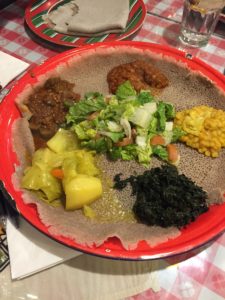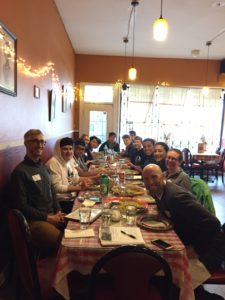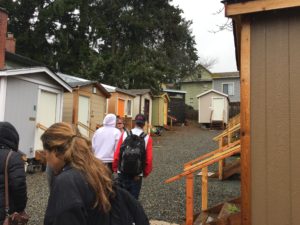At our Social Justice Day this year, Moses Rifkin, Emma Anderson, and I sponsored a track on Gentrification. Emma and I liked how we left the UPrep campus last year in our Data Collection track, so we wanted to mimic that and get the students off campus and see some of Seattle.
Seattle, at the time in 2016, had the largest number of cranes in any US city, putting on display how the city is experiencing a period of unbelievable growth. Typically, growth is a good thing…more jobs, higher GDP, more shops and more choices. But growth and progress isn’t always a good thing; more for some means less for others. Those “others,” are typically low-income urban residents and minorities who become pushed out of their neighborhoods because their businesses get purchased, property taxes rise, or rent become too high.
The Central District in Seattle is becoming gentrified; African-American owned businesses and homes are being pushed out by pot shops, boutiques, and expensive luxury condominiums for the incoming tech-boomer potential-residents who want to live close to where they work and have the goods and services that match their income level. We decided to invite speakers to share with our group and take a short tour of the Central District with our students.
Here’s how our day went:
We had students fill out anonymous index cards stating what they already knew about gentrification and questions they had about it. My favorite question was, ” How do you stifle gentrification without stifling a free market?”
Emma introduced the terms of gentrification and gave a brief history of gentrification in Seattle, including redlining in the 1930s and the racially restrictive covenants in housing and owning businesses, the Fair Housing Act of 1968 (nation wide), and a look at the Central District (CD) in 1970, where the demographics of the CD started changing really fast. It was staggering and sad how many African-Americans were “redlined” into living in the CD in the early part of the century because that was the only place they were allowed to live.
A very brief history…….After the end of WWII in 1945, returning WHITE servicemen were offered favorable housing deals in Seattle. This advantage allowed white people to gain major economic power which black folks did not have the privilege of having. In 1926-1968 it was legal to have housing covenants that specified which racial or ethnic groups were allowed to purchase or inhabit property in a neighborhood. Often, the only places where people of color could find housing was the CD and the International District.
The Fair Housing Act was passed in 1968, which made it illegal to discriminate in the sale, rental and financing of housing based on race, sex, religion or national origin. The Fair Housing Act supposedly stopped this discriminatory practice, but many deeds STILL have racist language in the neighborhood covenants and bylaws.
Emma stressed the fact that, though gentrification is not based on race……it is measured by differences in income levels, housing prices, and new structures built over time in a certain area, race and class are inextricable.
Here’s an interesting site called American Panorama that has some historical infographics, along with a maps of redlining where you can choose a region/city. Emma also showed us a University of Washington website called Seattle Civil Rights and Labor History Project which has a special Segregated Seattle section that has examples of the wording in racially restricted covenants, segregation maps over time, and oral histories.
We watched two videos from a native Central District product Draze, then connected with him on Skype. The two videos we watched, “The Hood Ain’t the Same,” and “Irony on 23rd,” highlighted Draze’s view of the changes in the CD.
When we talked to Draze, we learned how much he’d thought about the situation in the CD. He said much of the footage in “Irony on 23rd,” came from a protest on 4/20 on the presence of Uncle Ike’s Pot Shop, which opened right in the center of the CD on 23rd St. and Union Ave. Seattle was highly polarized with Uncle Ike’s. Draze shared the ironies….the pot shop is less than 3 feet from the Church where he’s worshipped since he was a kid, black people used to go to jail for years for possession of a dime bag of marijuana but now Uncle Ike’s makes millions from selling it legally on the same corner, and his statement in “Irony on 23rd, that, “The place of our ruin is a street called Union.”
One of our students, who grew up in the CD and is feeling firsthand the pressures of gentrification, asked Draze how to stop gentrification? Here’s what Draze said:
“First, can you name three black-owned businesses in Seattle?”
“Pressure elected officials on the issues including the rezoning of the CD, support African-American Owned businesses that still exist in the CD, get involved in AFRICA TOWN, and THE BOYZ (new black media magazine), use the African-American rideshare program, go to the Kotona Cafe instead of Starbucks, and reinvest in the community. The Montogomery Bus Boycotts worked because they had economic impacts…study them and find out how to support african american economic initiatives.”
“There’s nothing you can do to stop it, but we can slow the bleeding. The International District is the epicenter of the Asian Community. The CD needs to be the center of the African-American community.”
“The story of black america is the story of America.”
After Skyping with Draze, we got on the Puma Bus and headed to a public event space in the CD, where we had a 30 minute Q and A session with Gigi, a UPrep alum. Gigi shared her thoughts on how things have changed in the CD since she’s been alive, poor families are being forced out, and the legalization of marijuana has not had a positive effect on African-Americans primarily because most of the weed farm owners are white. Gigi mentioned how she knew the CD was changing…..when Dog Grooming stores started to replace the hair salons and small grocery stores.
We had lunch at the Chef Cafe, an Ethiopian restaurant on Jackson St. in the CD.
Pastor Steven Olsen was another contact person who we set up to hear from on our trip. He hung out at lunch and talked informally with some of the students sitting nearby, then met us at his church, the Lutheran Church of the Good Shepherd, and sponsored a tour of the Tiny House Village his parish sponsors. Pastor Olsen said that he feels passionately about the unfair effects of gentrification, and has lived in several big cities (Chicago, St. Louis) where he saw the effects of it as well as contributed to it (when he was in seminary and the housing provided by the school displaced established residents). He said the Tiny House Village was a way for his church to push back against the negative effects of gentrification and to give those whose voices and checkbooks are small a home in the neighborhood they choose.
This Social Justice Day was excellent, though I’m afraid students left sad, hopeless, and disempowered, as did I. Just in the 20 minute bus trip to the CD, we went through several housing developments that were under construction. It was staggering to see Uncle Ike’s pot shop right next to the church that has been on 23rd and Union for decades.
I’ll end this post recognizing that I, myself contribute to gentrification, when I choose Starbucks over the non-chain coffee place, when I vote for initiatives that seem to help Seattle “progress,” or when I choose to live in a nearly-all-white neighborhood. I learned how to counter gentrification from the speakers we heard, but it feels overpowering to me.
Send me a note if you have any good ideas, or know of a city that is growing well.




